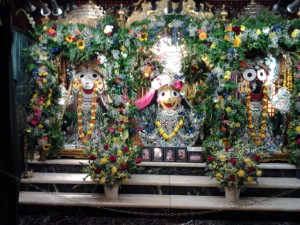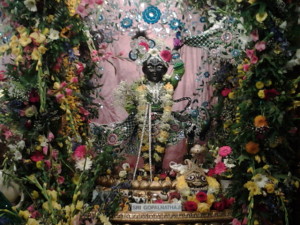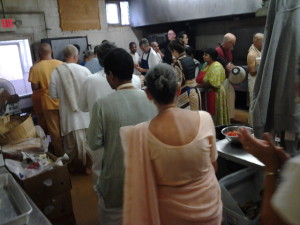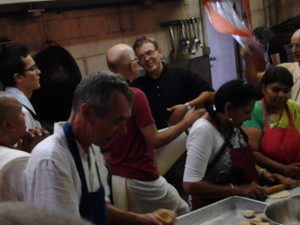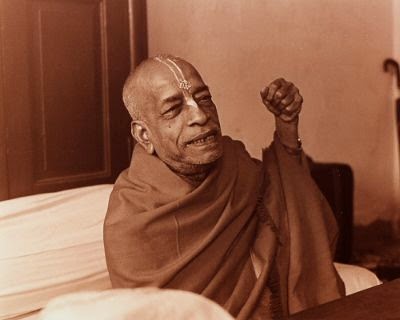The post More Parikrama pictures appeared first on SivaramaSwami.com.
More Parikrama pictures
Iskcon Krishna Balaram Temple’s Gomata Products Opens a New Wing of Offices (Album 61 photos)
→ Dandavats.com
 Vrindavana: 17- August 2014 Gomata Products opens a new wing of offices just inside the back Goshala Gate. Read more ›
Vrindavana: 17- August 2014 Gomata Products opens a new wing of offices just inside the back Goshala Gate. Read more › 21 Aug 2014 – Annada Ekadashi
→ ISKCON Desire Tree
Mahavishnu Swami’s Facebook Wall 2014-08-19 09:26:26
→ Mahavishnu Swami
Janmasthami and Vyasa Puja celebrations in Iskcon Hungary with fireworks, boat rides and more! (Album 146 HR photos)
→ Dandavats.com
 Beautiful arrangements, photos, do not miss them! Read more ›
Beautiful arrangements, photos, do not miss them! Read more › Prabhupada’s Appearance 19 August 2014 at ISKCON’s New Govardhana farm, Australia (Album 46 photos)
→ Dandavats.com
 1901 (circa) Young Abhay conducts his very own first Rathayatra. His father making a small cart, three feet high with a canopy resembling closely the huge carts in Puri. all the local children and many adults would come. Abhay stood out as a leader even then, as he organised and engaged everyone, even many of themothers were engaged by him in cooking, (especially his sister Bhavatarini), who all cooked special preparations to be offered and distributed as 'prasadam' at this Rathyatra festival. Read more ›
1901 (circa) Young Abhay conducts his very own first Rathayatra. His father making a small cart, three feet high with a canopy resembling closely the huge carts in Puri. all the local children and many adults would come. Abhay stood out as a leader even then, as he organised and engaged everyone, even many of themothers were engaged by him in cooking, (especially his sister Bhavatarini), who all cooked special preparations to be offered and distributed as 'prasadam' at this Rathyatra festival. Read more › Janmastami 2014 – Festivities at Krishna Balaram Mandir, Vrindavana (Album 54 photos)
→ Dandavats.com
 When Krishna does appear, He chooses His devotees to play the roles of His father and mother. He Himself plays the role of their child, and acts like a human being, while also performing superhuman activities that are impossible for anyone else to imitate. Read more ›
When Krishna does appear, He chooses His devotees to play the roles of His father and mother. He Himself plays the role of their child, and acts like a human being, while also performing superhuman activities that are impossible for anyone else to imitate. Read more › Sri Krishna Janmastami 2014 at Kalachandji’s Hare Krishna Temple in Dallas (Album 78 photos)
→ Dandavats.com
 Krishna's appearance is significant on many levels, and is something of a paradox. He's the beginningless Supreme Person, eternally existing everywhere at all times. Read more ›
Krishna's appearance is significant on many levels, and is something of a paradox. He's the beginningless Supreme Person, eternally existing everywhere at all times. Read more › The Mayapura-Vrindavana Trust guest house and restaurant in Vrindavana Opens for 2014 Fall Season (Album 33 photos)
→ Dandavats.com
 MVT guest house and restaurant are being efficiently managed by second generation devotees, Shyamasundar Aranya and Govinda going on their second year. MVT restaurant is opened to serve the residents and visitors of Vrindavan. Read more ›
MVT guest house and restaurant are being efficiently managed by second generation devotees, Shyamasundar Aranya and Govinda going on their second year. MVT restaurant is opened to serve the residents and visitors of Vrindavan. Read more › Where it all began! 26 2nd ave, New York: Ten Srila Prabhupada’s disciples gather to celebrate his appearance day!
→ Dandavats.com
 Packed house, 26 2nd ave. matchless gifts, the place where it all began, celebrating the appearance day of Srila Prabhupada. Prabhupada disciples present: Jayadvaita Swami, Abhiram, Rukmini, Yogesvara, Sruti Rupa, Bhumipati, Badarayana, Satyaraj, Pattarajni, Adi Purusha, Yadunandana Pada, Catur Vyuha, Laksmi Nrsimha Read more ›
Packed house, 26 2nd ave. matchless gifts, the place where it all began, celebrating the appearance day of Srila Prabhupada. Prabhupada disciples present: Jayadvaita Swami, Abhiram, Rukmini, Yogesvara, Sruti Rupa, Bhumipati, Badarayana, Satyaraj, Pattarajni, Adi Purusha, Yadunandana Pada, Catur Vyuha, Laksmi Nrsimha Read more › Srila Prabhupada’s Vyasa Puja celebration in Raman Reti, Alachua, Florida (Album 60 photos)
→ Dandavats.com
 As Abhay grew up he became more and more devoted to the Deity form of the Lord. He was especially enamoured with the Jagannatha Rathyatra festival that was held in Calcutta each year. Hearing and understanding the significance of the festival Abhay would sometimes check railway timetables to go to Jagannath Puri where Lord Caitanya personally attended some 500 years before. Every year a conservative estimated 5 million people attended the festival, this absorbed Abhay more in the mood of Rathyatra. Read more ›
As Abhay grew up he became more and more devoted to the Deity form of the Lord. He was especially enamoured with the Jagannatha Rathyatra festival that was held in Calcutta each year. Hearing and understanding the significance of the festival Abhay would sometimes check railway timetables to go to Jagannath Puri where Lord Caitanya personally attended some 500 years before. Every year a conservative estimated 5 million people attended the festival, this absorbed Abhay more in the mood of Rathyatra. Read more › Sri Krishna Janmashtami Maha Abhishek at Iskcon Delhi, 18th Aug, 2014 (Album 42 photos)
→ Dandavats.com
 Janmashtami is the yearly observance of Krishna's appearance on earth. It is one of the world's most widely observed spiritual festivals. Krishna's "birth," janma, occurred at midnight on ashtami, the eighth day after the full moon in the Vedic calendar. Read more ›
Janmashtami is the yearly observance of Krishna's appearance on earth. It is one of the world's most widely observed spiritual festivals. Krishna's "birth," janma, occurred at midnight on ashtami, the eighth day after the full moon in the Vedic calendar. Read more › Srila Prabhupada’s Appearance Day 2014 celebration at Iskcon San Diego (Album 82 photos)
→ Dandavats.com
 Srila Prabhupada was born Abhay Charan De on September 1st 1896 in Calcutta, India. His father was Gour Mohan De, a cloth merchant, and his mother was Rajani. His parents in accordance with Bengali tradition, employed an astrologer to calculate the child's horoscope, and they were made jubilant by the auspicious reading. The astrologer made a specific prediction: When this child reaches the age of seventy, he would cross the ocean, become a great exponent of religion, and open 108 temples. Read more ›
Srila Prabhupada was born Abhay Charan De on September 1st 1896 in Calcutta, India. His father was Gour Mohan De, a cloth merchant, and his mother was Rajani. His parents in accordance with Bengali tradition, employed an astrologer to calculate the child's horoscope, and they were made jubilant by the auspicious reading. The astrologer made a specific prediction: When this child reaches the age of seventy, he would cross the ocean, become a great exponent of religion, and open 108 temples. Read more › Srila Prabhupada 118th Vyasa Puja Celebrations in Iskcon Mumbai – 18 Aug 2014 (Album 20 photos)
→ Dandavats.com
 The appearance day of the Founder-Acharya of ISKCON was celebrated with glorification by the local devotees, more than 1008 food offerings, arati and distribution to lunch meal to every visitor to the temple. The offerings where thereafter distributed amongst devotees, visitors & underprivileged people. Read more ›
The appearance day of the Founder-Acharya of ISKCON was celebrated with glorification by the local devotees, more than 1008 food offerings, arati and distribution to lunch meal to every visitor to the temple. The offerings where thereafter distributed amongst devotees, visitors & underprivileged people. Read more › Lokanath Swami Maharaj leading Balaram Purnima Abhishek Kirtan
→ Gouranga TV - The Hare Krishna video collection
Lokanath Swami Maharaj leading Balaram Purnima Abhishek Kirtan
New Vrindaban’s Janmastami and Prabhupada Appearance Day Delights
→ New Vrindaban Brijabasi Spirit
Here is a picture story of New Vrindaban’s 44th Janmastami and Prabhupada’s Appearance Day festivals.
Hare Krsna!
HG Nityananda Chandra Prabhu / Śrīmad Bhāgavatam set presentation – Vyasa Puja evening
→ Kalachandji's Audio Archive
Srila Prabhupada’s Vyasa Puja Festival
→ Kalachandji's Audio Archive
HG Ananga Manjari Mataji – Morning talk on Srila Prabhupada
→ Kalachandji's Audio Archive
HG Ananga Manjari Mataji / SB.10.68.09-10
→ Kalachandji's Audio Archive
Everyone who participates in wrongdoing is culpable
→ The Spiritual Scientist
“Not only the performer of the theft but also anyone who assists him, instigates the crime, or simply approves of it must also share the reaction in the next life. According to their degree of participation, they each must suffer a proportionate consequence” (Srimad Bhagavatam 11.27.55).
Violence has its utility, but it shouldn’t be abused
→ The Spiritual Scientist
“Violence also has its utility, and how to apply violence rests with the person in knowledge. Although the justice of the peace awards capital punishment to a person condemned for murder, the justice of the peace cannot be blamed, because he orders violence to another person according to the codes of justice. In Manu-saàhitä, the lawbook for mankind, it is supported that a murderer should be condemned to death so that in his next life he will not have to suffer for the great sin he has committed. Therefore, the king's punishment of hanging a murderer is actually beneficial”(Bg 2.21 purport).
The weapon for waging the world’s most formidable spiritual war (Srila Prabhupada Vyasa-puja Offering 2014)
→ The Spiritual Scientist
Dear Srila Prabhupada,
Please accept my humble obeisances at your lotus feet. All glories to your divine self.
Among the many things that inspire me about you, the most inspiring in recent times has been your song “Markine Bhagavata-dharma.” This song composed as a prayerful request to your beloved Lord Krishna reveals not just the intimacy of your devotion to him. It also reveals the strategy you planned to use for waging on his behalf a war of the kind that had rarely, if ever, been fought before by a spiritual commander.
You had embarked at an advanced age, utterly alone and practically penniless, for sharing the spiritual wisdom of Krishna with the materialistic culture of the West – that too at its headquarters, America. In this mission, you were like a warrior set to single-handedly take on a formidable army, as did Arjuna at Virata. Your war was in a sense much tougher because you were confronting the opponent on its home turf – a territory physically, culturally and intellectually foreign to you.
For a warrior on any battle, the key possession, the thing to which one’s thoughts go repeatedly, is one’s most potent weapon. So, naturally as you approached the American coastline, your thoughts went to your most important weapon, what you considered your trump card. This song reveals that spiritual game-changer: the process of hearing about Krishna.
Hearing is what the whole song centers on, literally and conceptually. Literally, you placed at its center the Sanskrit Bhagavatam verses (1.2.17-21) that delineate how hearing works. Conceptually, you analyze in the preceding and succeeding Bengali verses that you composed the obstacles to that process and the ways to overcome them. The primary obstacle to the working of the process (vaasudeb-katha ruchi nahe se prasanna) that you apprehended was the predominance of the modes of passion and ignorance in the minds of your audience (rajas tamo gune era sabaai aacchanna).
The way you envisioned the obstacles reveals your deep shastra-chakshu. You did not dwell on the many obvious obstacles that would have intimidated a lesser mortal: the intellectual unfamiliarity of the message, the cultural strangeness of the messenger, the probable unintelligibility of an Indian accent and so forth. You knew about these obstacles, but you didn’t consider them noteworthy. The only noteworthy obstacle for you was the universal obstacle, as revealed by scripture, to understanding krishna-katha: the predominance of the lower modes.
And your apprehension of the obstacle formed the foundation of your prayer. You didn’t pray for a smooth landing or a warm reception or even for life’s basic necessities. None of these were guaranteed as you were going to be received by an utter stranger at the request of a person who was at best your casual acquaintance. You were going to live with strangers, but this song reveals that you were living with Krishna. You had complete faith that he would be with you always, no matter how much stranger your living conditions might become.
To your beloved Lord you prayed not for any material necessity, but for the removal of the main obstacle to your spiritual mission. You prayed that Krishna use his matchless mystical potency (sakal-i sambhava hoya tumi se kautuki) to make the message comprehensible to your audience. You beseeched the universal spiritual master (akhila jagat-guru) to ornament your speech (bacana se aamaar alankrita koribaar) so that it would become attractive to them.
And how wonderfully Krishna ornamented your message as it attracted over the next eleven years millions, inspiring them to dedicate their lives for seeking and serving him.
Among the many ornaments that adorned your krishna-katha, the most endearing and disarming was your compassion. You were tirelessly and fearlessly concerned for everyone, all of whom you saw as potential recipients of krishna-katha. It was this concern that made you speak krishna-katha all day while there were people ready to hear. And it was that same compassion that made you speak almost all night while the world slept. Though the audience slumbered, you persevered, preparing books that they could read when they woke physically and spiritually. The krishna-katha that emanated from the innermost core of your heart settled in the deepest recesses of the hearts of millions of sincere seekers, transforming forever their activities and their destinies.
Thus, the transmission of krishna-katha formed the crux of your war strategy. And you never changed this strategy even as your mission spread incredibly all over the globe, encountering seemingly insurmountable obstacles and scaling apparently unreachable peaks. In one of the last messages that you gave us before you departed from mortal vision, you quoted from the same section of the Bhagavatam, emphasizing the potency of hearing in association and urging us to seek protection in that potency.
Srila Prabhupada, I am forever grateful to you for not just sharing krishna-katha so courageously and vigorously, but also for inspiring your followers to do the same and for setting up ISKCON for doing so. I was most fortunate to be introduced to krishna-katha by your disciples and grand-disciples in a culture that cherished the tradition of hearing – and encouraged the asking of questions to address individual hearer’s needs. Over the last two decades, I have heard thousands of classes and asked thousands of questions – and I will continue to do so for the rest of my life, as I relish the timeless nectar-treasure that you brought to the world.
At the same time, I feel acutely and urgently the weight of your standing order to all your followers that they share what they have received. By your mercy, by the guidance of my spiritual mentors, and due to my own physical limitations, I have over the last few years realized the Internet universe to be my most promising guru-datta-desha – an eminently fertile field for sowing the seeds of krishna-katha. ISKCON’s presence on the Internet is still underdeveloped. Though we have a good amount of devotional content, very little of it is customized to systematically groom online seekers.
Through my fledgling attempts at playing the digital brihat-mridanga, I have been making small inroads in this vast terrain, answering over seventeen hundred questions from hundreds of people from various parts of the world. And in what I hope will be a pleasing service rendered over the course of the last year, I helped prepare ISKCON’s first fully online version of the Bhakti-shastri course – the course that you considered foundational for serious devotees.
Given the fast-paced life of today, I have also tried to make krishna-katha, specifically the wisdom of the Bhagavad-gita, accessible through fresh daily meditations. Similar reflections on the Bible take its message daily to millions through the Internet, but no such reflections on the Gita were available – a gap that I felt inspired to fill. In 300-word reflections that can be read in two-three minutes, I try to explain the Gita's relevance in the contemporary context.
Past writers in our tradition have glorified Krishna poetically and artistically in the prevalent languages of their times such as Sanskrit or Bengali. I attempt to follow in their illustrious footsteps in my insignificant way by doing the same in English. I endeavor to ornament each Gita-daily article with literary devices so as to make the krishna-katha more memorable and relishable.
Writing Gita-daily is my humble attempt to expand to the digital and the literary arena on a daily basis the tradition of transmission of krishna-katha that you established through ISKCON’s daily classes. I am immensely grateful to have been able to glorify the Gita daily for nearly three years now.
I pray earnestly and fervently for mercy and intelligence so that I can continue to receive, relish and share krishna-katha for the rest of my life.
Seeking your mercy to stay immersed eternally in Krishna’s message of love,
Your servant
Chaitanya Charan das
Prabhupada Letters :: Anthology 2014-08-19 01:23:00 →
Prabhupada Letters :: 1968
Prabhupada Letters :: Anthology 2014-08-19 01:22:00 →
Prabhupada Letters :: 1968
Prabhupada Letters :: Anthology 2014-08-19 01:21:00 →
Prabhupada Letters :: 1968
Prabhupada Letters :: Anthology 2014-08-19 01:16:00 →
Prabhupada Letters :: 1968
Prabhupada Letters :: Anthology 2014-08-19 01:11:00 →
Prabhupada Letters :: 1969
Prabhupada Letters :: Anthology 2014-08-19 01:09:00 →
Prabhupada Letters :: 1971
Prabhupada Letters :: Anthology 2014-08-19 01:06:00 →
Prabhupada Letters :: 1973
Japa Is The Cornerstone
→ Japa Group
If the cornerstone is solid and strong, then the rest of the house will be the same....so with your Japa, if it is strong and solid, then the rest of our spiritual life will be the same.
Saturday, August 16th, 2014
→ The Walking Monk
Friday, August 15th, 2014
→ The Walking Monk
Thursday, August 14th, 2014
→ The Walking Monk
Wednesday, August 13th, 2014
→ The Walking Monk
Tuesday, August 12th, 2014
→ The Walking Monk
Good Thoughts for Robin
When going through the security screening at the Vancouver Airport, a monitor was reporting the news of the death of comedian, Robin Williams. That’s sad. He made a lot of people laugh. God produced a very talented man in him.
When getting fetched at the Toronto Airport, greeter, Rajneesh, informed me how Mr. Williams gave up his own life due to depression. That’s also sad. It’s like the proverbial symptom of the sad clown.
It is well understood that life is tough and that there are hard circumstances to bear. Many of us live a dual world with heaviness in the heart while we show a bright face. To Robin we offer our respects and wish him a good chance in the next life.
News of this sudden departure caught my attention once again momentarily in the course of a cooling evening walk. It brought my thoughts to the mode of prayer. When I was just recently in Vancouver I was approached by someone who admitted to having a rocky marriage with a spouse. The person asked that I please put prayers out for the relationship’s salvation.
Reassuringly I said, “Of course I will.” Thinking of Robin’s going reminded me of prayer being important. It usually means sending good vibes out there and a call for help. It throws you into a wholesome dependency. Now, just because I play a spiritual role doesn’t mean I’m the only one to enlist in this practice of prayers. It’s for everyone.
May the Source be with you!
5 KM
August 18th, 2014 – Janmastami Day Dress
→ Mayapur.com
The post August 18th, 2014 – Janmastami Day Dress appeared first on Mayapur.com.
To realize everything is illusion amidst adversities, is yoga and pranayama the way or is bhakti-yoga sufficient?
→ The Spiritual Scientist
From Anusha
How do we establish ourselves in ‘the’ true nature? In the face of adversities, how do we maintain our inner peace and remember that everything is but an illusion? Is Yoga and Pranayama the way to do it, or is Bhakthi Yoga sufficient?
As developing internal conviction takes time, isn’t it better to be stimulated in our devotion by external inspiration?
→ The Spiritual Scientist
From Satyam P
Question based on this Gita-daily article: Why do our resolutions crash between takeoff and landing?
When you say that we have to be convinced, prji dont you think it is a long process which might take a long time to happen and our flight might not even start to take-off if we are waiting for the day our convictions will get internalized. On the contrary the external stimuli viz. talks, anecdotes, etc. do offer a hasty flight but at least we begin. So prji what should be a right balance of externalization and internalization
When the number of breaths of a soul in a body are fixed, how can a purpose-driven attitude increase longevity?
→ The Spiritual Scientist
This question is based on this statement from the article "After the laughter":
"He reports how the inmates who couldn’t find any meaning or purpose to their sufferings succumbed much earlier than their biological capacity to endure. In contrast, those who could find meaning and purpose were able to survive much longer and eventually emerged stronger through their harrowing experiences."



